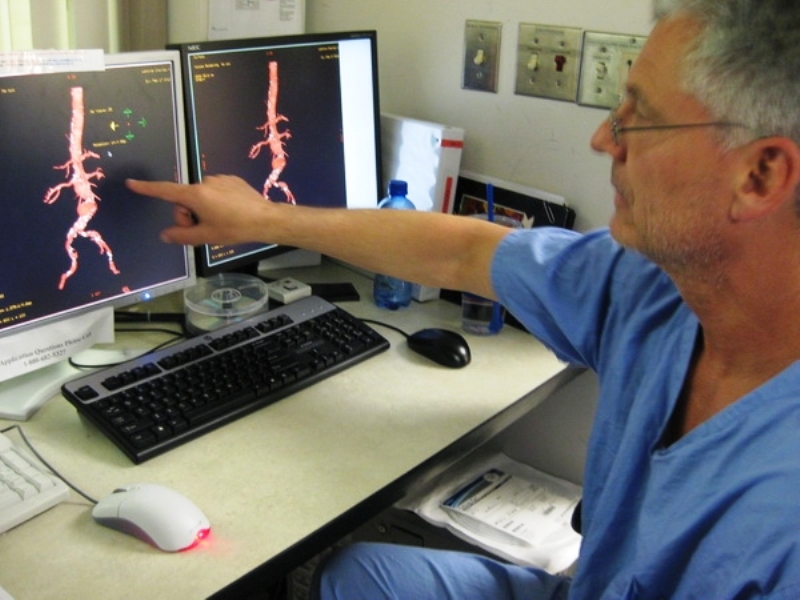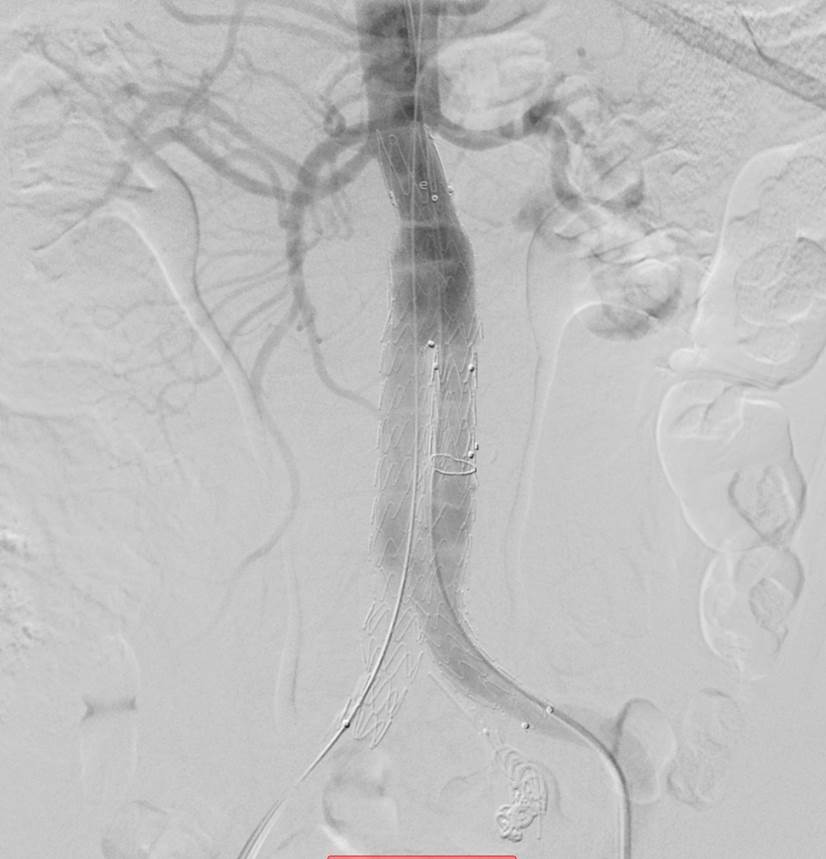Atherosclerosis of the aorta of the heart, what is it?
Author Ольга Кияница
2018-11-30
Aortic atherosclerosis is a systemic pathology, often caused by a violation of fat metabolism. In this form of atherosclerotic development, the aortic wall is affected, although in addition large and medium caliber vessels may be involved in the pathological process.
According to ICD-10, aortic atherosclerosis is assigned a code of 170.0.
Features of the course of the disease contribute to the fact that in rare cases it is possible to diagnose aortic atherosclerosis at an early stage. Nevertheless, at the slightest suspicion, instrumental methods of investigation can be used to clarify the localization of the area of the aorta affected by atherosclerosis.
Video: Atherosclerosis Causes Symptoms and Effects
Description of aortic atherosclerosis
Aortic atherosclerosis is a medical term describing a very serious condition in which the aorta, the largest artery in a person, is prone to sclerosis due to the proliferation of atheromatous plaque in the vessel wall.
The aorta is the main vessel of the circulatory system. It moves away from the left ventricle, rises, bends, and then descends. Then it passes through the chest and abdominal cavities and is divided into two iliac arteries that supply blood to the right and left lower limbs.
Given this anatomical location in the aorta, there are three main sections:
- Ascending department.
- Aortic arch, resembling an inverted U.
- Downstream department.
The last section of the aorta, that is, the descending part, is further divided into the thoracic and abdominal parts. The first is located above the diaphragm, and the second - under the diaphragm.
Starting from the ascending part, smaller arteries depart from the aorta, through which blood flows to all organs and tissues. Disruption of blood flow in any part of the aorta leads to serious dysfunction of the corresponding system of the body or a separate organ.
Like all arteries in the human body, the aorta is elastic in nature and consists of layers of smooth muscle fibers, nerve cells and endothelial cells.

The mechanism of development of atherosclerosis of the aorta
Atherosclerosis (or arteriosclerosis) is a life-threatening vascular disease, as it leads to the accumulation of fat-like formations (plaques) on the inner walls of arteries.
Atherosclerotic plaques tend to thicken over time. They also make the arteries more rigid, due to which the vessel loses its ability to expand and contract. In critical cases, they completely block the arteries and the blood stops flowing through them.
If such a dangerous disease happens to the vital artery of the aorta type, irreparable can happen at any time. This fatal condition is called aortic atherosclerosis .
The aorta is one of the first large arteries that can be affected by atherosclerosis. Atherosclerotic constriction may occur together, before, or after atherosclerosis of the coronary or carotid vessels. In severe cases, the atherosclerotic process can affect five parts of the aorta at the same time or move alternately from one to the other.

Symptoms of aortic atherosclerosis
The general signs of the disease largely depend on the location of the affected department. For example, one clinic is observed in atherosclerotic lesions of the thoracic aorta, and the other in the abdominal (abdominal) part of the aorta.But in most cases, at the early stages of atherosclerosis, there are no signs. The process itself can last for decades; therefore, often in old age the first signs of the disease begin to be determined.
Almost 75% of atherosclerosis of the aorta accounts for its abdominal part, which is located in the abdominal cavity. The remaining 25% relate to the thoracic part of the descending aorta, passing in the posterior mediastinum of the chest cavity.
According to the New England Journal of Medicine, atherosclerosis of the thoracic aorta is a potential high risk factor for the formation of cerebral embolism and the development of ischemic stroke.
Back pain is a common symptom of atherosclerosis of the abdominal aorta. There may also be pain in the abdomen or chest.
Symptoms of atherosclerosis of the thoracic aorta:
- Retrosternal pain that can become burning and occur periodically.
- Increase in blood pressure, often upper, systolic, indicator.
- Discomfort when swallowing food.
- Frequent dizziness and there may even be bouts of unconsciousness.
- Determination of fat deposits on the face (adipose).
- Enhanced hair growth in the ears.
- Premature occurrence of gray hair.
Additionally, in some patients on the iris of the eye (on its outer shell), a whitish band appears.
Signs of atherosclerosis of the abdominal aorta:
- Pain in the abdomen, which often appear immediately after a meal and then disappear after about two hours.
- With uncomplicated atherosclerosis, the pain is most often aching.
- Violation of intestinal motility, which may manifest as bloating, diarrhea, constipation, etc.
- Changes in blood pressure, often in the direction of its increase.
- The development of renal failure.
In severe cases, when such a complication is manifested, such as thrombosis of intestinal vessels, severe abdominal pain occurs, which are not eliminated by painkillers and can increase in their strength.
Causes of aortic atherosclerosis
The exact causes of the pathology are unknown for today. However, there are specific conditions that increase the risk of developing the disease. Sometimes these high risk factors can be controlled. First of all, they include:
- lack of physical activity;
- rich in fats;
- cigarette smoking;
- obesity.
Other predisposing factors cannot be controlled - these are non-modifiable conditions. First of all, they include age (atherosclerosis occurs more often after 55 years) and dysfunctional heredity, which is why even in newborns the initial signs of atherosclerosis can be determined.
High cholesterol is the main indicator of the active passage in the body of the atherosclerotic process.
When making major changes in lifestyle, nutritional intake, body weight, along with regular intake of prescribed medications, it is possible to prevent or at least stop aortic damage caused by atherosclerosis.
Video: Aortic Atherosclerosis | Pathology
Answers to frequently asked questions
What is the diagnosis of aortic atherosclerosis?
Compared with other forms of this common disease, aortic atherosclerosis is rare. For this reason, when pain in the chest or abdomen appears, it is far from always suspicious of atherosclerotic aortic lesions. That is why this disease, devoid of typical symptoms, is most often determined during the examination for some other pathology. For example, if a tumor process is suspected, a contrast X-ray examination can be carried out, in assessing which the oncologist radiologist can determine the disturbance of the aortic wall.
Changes in the aorta due to atherosclerotic damage can be determined using the following research methods:
- Ultrasound diagnosis (heart and aorta), combined with electrocardiography.
- Angiography, which, if necessary, can be supplemented with coronarography.
- Magnetic resonance imaging.
- Scanning (duplex and triplex).

Laboratory tests, such as lipid profile, cholesterol levels, etc., are performed to confirm the atherosclerotic process. In some cases, consultation of related specialists may also be required, especially when choosing treatment tactics.
What is the current treatment for aortic atherosclerosis?
The quality of treatment largely depends on how early it is started. The best results are observed when starting therapy in the early stages of the disease. Most often follow the following treatment directions:
- Reducing the amount of cholesterol in the blood.
- Stimulation of cholesterol excretion from the body.
- Treatment of concomitant pathological manifestations.
In atherosclerosis of the aorta of the heart, the following drugs are most often used:
- Statins - affect the amount of cholesterol in the blood, so they are most often used to treat atherosclerosis.
- Fibrates also reduce the level of “bad” lipids, but at the expense of slowing down the synthesis in the body's own fats.
- Nicotinic acid and its derivatives - helps to increase the amount of “good” lipids, additionally reduces the concentration of triglycerides and cholesterol.
- Sequestrants of bile acids - do not allow cholesterol to be absorbed in the intestine, so that its amount in the blood does not increase.
The above groups of medications have their own indications and contraindications, therefore their use without medical prescription is absolutely not recommended. Also, if the doctor's instructions are not fulfilled, there may be adverse reactions from the gastrointestinal tract and the liver. In view of this, first of all, it is necessary to consult a local doctor (family doctor), and then, if necessary, a referral to a narrower specialist can be issued.
Proper nutrition is important in the treatment of aortic atherosclerosis. When building a strategy of drug exposure, attention is paid to diet. Additionally, drugs containing polyunsaturated fatty acids and vitamin complexes may be prescribed.
In extreme cases, surgical intervention may be required when the vessel walls are strengthened with a stent or other similar method. Angioplasty may also be performed, but this is already in the event of serious damage to the vessel. In general, adversely occurring atherosclerosis of the aorta of the heart can be complicated by renal ischemia, myocardial infarction and ischemic stroke.

Stent graft implantation
The prognostic conclusion for aortic atherosclerosis depends on the stage of the disease development. If the correction of predisposing factors was performed in a timely manner, then the risk of mortality is noticeably reduced. In this regard, it is best to carry out prevention of the disease.
Is it possible to prevent the development of atherosclerosis of the aorta of the heart?
The basis for the prevention of any form of atherosclerosis is to prevent the increase in cholesterol levels, for which various methods can be used, both folk or natural, and medication. As a result, plaques will not be deposited on the walls, and this allows the vessels to function normally.
Reducing the likelihood of developing atherosclerosis depends on the following actions:
- You must first give up bad habits, especially smoking, which at times increases the likelihood of atherosclerosis.
- With food, up to 30% of total cholesterol comes into the body, therefore, it is necessary to properly formulate a diet and make it the norm. It is especially important not to consume animal fats, as well as products treated with palm or other similar oils.
- The appearance of the most minor signs, which were noted above, should alert and become a reason to visit the doctor and then undergo the necessary research.
- In the presence of diseases such as obesity, diabetes mellitus or hypertension, it is necessary to immediately treat them.This will reduce the likelihood of atherosclerosis of the aorta and other vessels of the body.
- Physical activity must be maintained at a sufficient level so that the body is not overstrained, but even before hypodynamia one should not bring the matter. In particular, sometimes it is enough to regularly engage in an acceptable for health reasons sport to improve health and delay time for the development of atherosclerosis.
Additionally, one should not be exposed to stress and try to undergo medical examinations every year. As a result, the risk of developing atherosclerosis of the aorta of the heart will be reduced, and the quality of life will be maintained at a high level.
Video: Live great! Atherosclerosis of the aorta. How to return blood flow to normal

У матери такое заболевание было…оно сейчас вообще очень распространено, к сожалению(( Поэтому в наших интерессах заниматься профилактикой. Врач сказал, очень важны полезные жиры. Стал по его совету принимать двойную омегу-3 от эвалар. Именно ее, потому что с ней получается максимальная концентрация в суточном приеме.+слежу за питанием, стараюсь меньше вредностей есть. С сосудами полный порядок, слава богу.